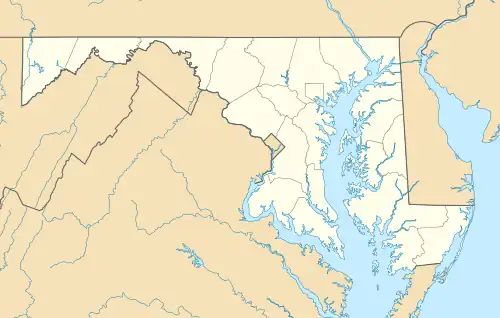David Taylor Model Basin
The David Taylor Model Basin (DTMB) is one of the largest ship model basins—test facilities for the development of ship design—in the world. DTMB is a field activity of the Carderock Division of the Naval Surface Warfare Center.
Taylor, David W., Model Basin | |
 | |
  | |
| Location | Bounded by MacArthur Blvd. and Clara Barton Pkwy., Bethesda, Maryland |
|---|---|
| Coordinates | 38°58′27″N 77°11′22″W |
| Area | 32 acres (13 ha) |
| Built | 1938 |
| Built by | Turner Construction Co. |
| Architectural style | Art Deco |
| NRHP reference No. | 85003231[1] |
| Added to NRHP | 17 October 1985 |
History
In 1896, David Watson Taylor designed and supervised construction of the Washington Navy Yard's Experimental Model Basin which was at that time the best facility in the world. That facility was a significant design testing capability before, during, and after World War I. Inadequacies in that facility led the navy to look for a new model capability.[2]
The new navy modeling facility—named for David Taylor—was built in 1939 in today's community of Carderock just west of Bethesda, Maryland in Montgomery County. The Carderock facility contains multiple test basins (towing tanks for models) designed for a variety of testing capabilities. DTMB has strongly influenced naval architecture for 70 years.
Technical capabilities
Three adjoining sections comprise the Shallow Water Basin: deep water, shallow water, and a J-shaped turning basin used for steering maneuvers. Its carriage can provide speeds up to 18 knots.
The Deep Water Basin wavemaker located along the side, and a wave absorbing beach at the other. The wavemaker consists of 216 electro-mechanical panels called wave boards.[3] This capability allows modeling of regular or irregular sea states. Located behind a movable section of the beach is a fitting out dry dock. Its carriage can provide speeds up to 20 knots.
The High-Speed Basin comprises two adjoining sections: a deep water section and a shallow water section. Wavemaking capability exists in this basin, and there are three large underwater viewing windows at different elevations which are set into the wall about mid-length. The high-speed carriages can provide complex motions for the model at speeds up to 50 knots.
Computing
The David Taylor Model Basin was an early adopter of computers, and an active site for computer technology. Represented by Betty Holberton, it was one of three government agencies present at the 1959 meeting where the computer language COBOL was created.[4]
References
- "National Register Information System". National Register of Historic Places. National Park Service. 9 July 2010.
- Allison, David K. (July 1984). "National Register of Historic Places Registration: David Taylor Model Basin" (PDF). Maryland Historical Trust. Retrieved 1 January 2016.
- "New MASK Unveiled - Magazines". magazines.marinelink.com. Retrieved 27 December 2021.
- Sammet, Jean (1978). "The Early History of COBOL". ACM SIGPLAN Notices. Association for Computing Machinery. 13 (8): 121–161. doi:10.1145/960118.808378. Retrieved 4 April 2023.
Further reading
- Carlilse, Rodney (1998). Where the Fleet Begins: A History of the David Taylor Research Center. Dept. of the Navy. p. 689. ISBN 978-0160494420.
- Conn, Virginia (1971). The David Taylor Model Basin: A Brief History. Naval Historical Foundation. p. 28. ASIN B000710GA6.
- "A Historical Mechanical Engineering Landmark" (PDF). Archived from the original (pdf) on 14 March 2012. Retrieved 4 January 2011.
- "David Taylor Model Basin". Archived from the original on 10 April 2010. Retrieved 4 January 2011.
- "Facility Data Sheet -Shallow Water Basin". Archived from the original on 8 April 2009. Retrieved 4 January 2011.
- "Facility Data Sheet - Deep Water Basin". Archived from the original on 28 June 2008. Retrieved 4 January 2011.
- "Facility Data Sheet - High Speed Basin". Archived from the original on 28 June 2008. Retrieved 4 January 2011.

